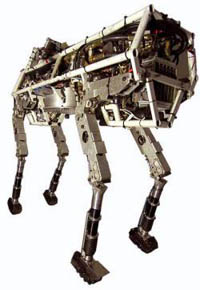New robot can sense damage and compensate
When people hurt a leg, they often can make do by limping or using a crutch until they feel better. Now, there is a robot that similarly can cope with injury.

The ability to compensate can be vital in new or dangerous situations where unexpected damage or injury can occur.
Researchers at Cornell University in New York, built a four-legged robot that can sense damage to its body and determine how to adjust and keep going. They report the development in Friday's issue of the journal Science.
Most robots are used in industrial applications where their environment never changes, explained Hod Lipson, a co-author of the paper. If they are to become useful outdoors or at home, they need to be able to cope with changes, he said.
The robot has tilt sensors and angle sensors in each of its joints and uses the readings from these devices to create a computer model of its own structure and movement. When the sensors indicate a change, it can then alter the model to compensate.
While most robots operate using a computer model they have been programmed with, this one develops its own model by analyzing how its parts respond to commands to move.
That allows it to change its own program if something occurs that it did not expect.
For example, Lipson said, the robot could have one of its motors jam as it moved about. Its self-model might predict forward movement when that motor is started, and if that does not happen it could adjust its self-image to the new situation.
In one example, the researchers shortened one of the robot's legs, and it responded by changing its gait.
"We never officially named it, but we usually refer to it as the Starfish robot, even though a real starfish has five rather than four legs," said lead researcher Josh Bongard, now at the University of Vermont. "Also, a real starfish is much better than our robot at recovering from injury, because it can actually regrow its legs."
In effect, suggests Christoph Adami of the Keck Graduate School of Applied Life Sciences in California, the internal computer model enables the robot to develop a sense of self or self image, reports AP.
The next step, according to Adami, who was not part of the research team, could be a robot that could also develop an idea of its environment. It could explore an area and, if stymied by an obstacle, it might pause and try to "think" of a way to overcome the problem, he said in a commentary on the report.
Lipson said the same technology could be used in other settings.
For example, he said, a bridge might have a computer programmed to monitor movement and vibration. If it should sense a change indicating a weakness in some part of the structure, it could turn on a red light to stop traffic and send an alarm to highway officials.
The researchers are now working to find other applications for the technology and to make it more complex.
Subscribe to Pravda.Ru Telegram channel, Facebook, RSS!


